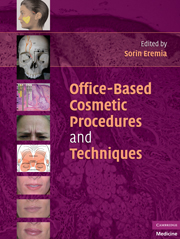Book contents
- Frontmatter
- Contents
- PREFACE
- CONTRIBUTORS
- PART ONE ANATOMY AND THE AGING PROCESS
- PART TWO ANESTHESIA AND SEDATION FOR OFFICE COSMETIC PROCEDURES
- PART THREE FILLERS AND NEUROTOXINS
- Chap. 6 FILLERS: PAST, PRESENT, AND FUTURE
- Chap. 7 HYALURONIC ACID FILLERS: HOW STRUCTURE AFFECTS FUNCTION
- Chap. 8 RESTYLANE: GENERAL CONCEPTS
- Chap. 9 THE RESTYLANE FAMILY OF FILLERS: CANADIAN EXPERIENCE
- Chap. 10 THE JUVÉDERM FAMILY OF FILLERS
- Chap. 11 PURAGEN: A NEW DERMAL FILLER
- Chap. 12 PURAGEN: ASIAN EXPERIENCE
- Chap. 13 REVIEW OF COLLAGEN FILLERS
- Chap. 14 HUMAN AND BOVINE COLLAGEN-BASED FILLERS
- Chap. 15 PORCINE COLLAGEN: EVOLENCE
- Chap. 16 CALCIUM HYDROXYLAPATITE (RADIESSE): A FACIAL PLASTIC SURGEON'S APPROACH
- Chap. 17 CALCIUM HYDROXYLAPATITE (RADIESSE): A DERMASURGEON'S APPROACH
- Chap. 18 CALCIUM HYDROXYLAPATITE FOR HAND VOLUME RESTORATION
- Chap. 19 LONG-LASTING FILLERS: HOW STRUCTURE AFFECTS FUNCTION
- Chap. 20 ACRYLIC PARTICLE–BASED FILLERS: ARTEFILL
- Chap. 21 POLY-L-LACTIC ACID FILLERS
- Chap. 22 POLY-L-LACTIC ACID (SCULPTRA) FOR HAND VOLUME RESTORATION
- Chap. 23 BIOALKAMIDE
- Chap. 24 SILICONE
- Chap. 25 AUTOLOGOUS FAT TRANSFER: AN INTRODUCTION
- Chap. 26 SMALL-VOLUME FAT TRANSFER
- Chap. 27 LARGER-VOLUME FAT TRANSFER
- Chap. 28 FAMI TECHNIQUE AND FAT TRANSFER FOR HAND REJUVENATION
- Chap. 29 ADDING VOLUME TO THE AGING FACE: FAT GRAFTING VERSUS FILLERS AND IMPLANTS IN EUROPE
- Chap. 30 FILLERS: HOW WE DO IT
- Chap. 31 CHOOSING A FILLER
- Chap. 32 FILLER COMPLICATIONS
- Chap. 33 NEUROTOXINS: PAST, PRESENT, AND FUTURE
- Chap. 34 BOTOX: HOW WE DO IT
- Chap. 35 COSMETIC BOTOX: HOW WE DO IT
- Chap. 36 BOTOX: BEYOND THE BASICS
- Chap. 37 BOTOX FOR HYPERHIDROSIS
- Chap. 38 DYSPORT
- Chap. 39 NEUROTOXIN ALTERNATIVE: RADIOFREQUENCY CORRUGATOR DENERVATION
- Chap. 40 FILLERS AND NEUROTOXINS IN ASIA
- Chap. 41 FILLERS AND NEUROTOXINS IN SOUTH AMERICA
- PART FOUR COSMETIC APPLICATIONS OF LIGHT, RADIOFREQUENCY, AND ULTRASOUND ENERGY
- PART FIVE OTHER PROCEDURES
- INDEX
- References
Chap. 15 - PORCINE COLLAGEN: EVOLENCE
from PART THREE - FILLERS AND NEUROTOXINS
Published online by Cambridge University Press: 06 July 2010
- Frontmatter
- Contents
- PREFACE
- CONTRIBUTORS
- PART ONE ANATOMY AND THE AGING PROCESS
- PART TWO ANESTHESIA AND SEDATION FOR OFFICE COSMETIC PROCEDURES
- PART THREE FILLERS AND NEUROTOXINS
- Chap. 6 FILLERS: PAST, PRESENT, AND FUTURE
- Chap. 7 HYALURONIC ACID FILLERS: HOW STRUCTURE AFFECTS FUNCTION
- Chap. 8 RESTYLANE: GENERAL CONCEPTS
- Chap. 9 THE RESTYLANE FAMILY OF FILLERS: CANADIAN EXPERIENCE
- Chap. 10 THE JUVÉDERM FAMILY OF FILLERS
- Chap. 11 PURAGEN: A NEW DERMAL FILLER
- Chap. 12 PURAGEN: ASIAN EXPERIENCE
- Chap. 13 REVIEW OF COLLAGEN FILLERS
- Chap. 14 HUMAN AND BOVINE COLLAGEN-BASED FILLERS
- Chap. 15 PORCINE COLLAGEN: EVOLENCE
- Chap. 16 CALCIUM HYDROXYLAPATITE (RADIESSE): A FACIAL PLASTIC SURGEON'S APPROACH
- Chap. 17 CALCIUM HYDROXYLAPATITE (RADIESSE): A DERMASURGEON'S APPROACH
- Chap. 18 CALCIUM HYDROXYLAPATITE FOR HAND VOLUME RESTORATION
- Chap. 19 LONG-LASTING FILLERS: HOW STRUCTURE AFFECTS FUNCTION
- Chap. 20 ACRYLIC PARTICLE–BASED FILLERS: ARTEFILL
- Chap. 21 POLY-L-LACTIC ACID FILLERS
- Chap. 22 POLY-L-LACTIC ACID (SCULPTRA) FOR HAND VOLUME RESTORATION
- Chap. 23 BIOALKAMIDE
- Chap. 24 SILICONE
- Chap. 25 AUTOLOGOUS FAT TRANSFER: AN INTRODUCTION
- Chap. 26 SMALL-VOLUME FAT TRANSFER
- Chap. 27 LARGER-VOLUME FAT TRANSFER
- Chap. 28 FAMI TECHNIQUE AND FAT TRANSFER FOR HAND REJUVENATION
- Chap. 29 ADDING VOLUME TO THE AGING FACE: FAT GRAFTING VERSUS FILLERS AND IMPLANTS IN EUROPE
- Chap. 30 FILLERS: HOW WE DO IT
- Chap. 31 CHOOSING A FILLER
- Chap. 32 FILLER COMPLICATIONS
- Chap. 33 NEUROTOXINS: PAST, PRESENT, AND FUTURE
- Chap. 34 BOTOX: HOW WE DO IT
- Chap. 35 COSMETIC BOTOX: HOW WE DO IT
- Chap. 36 BOTOX: BEYOND THE BASICS
- Chap. 37 BOTOX FOR HYPERHIDROSIS
- Chap. 38 DYSPORT
- Chap. 39 NEUROTOXIN ALTERNATIVE: RADIOFREQUENCY CORRUGATOR DENERVATION
- Chap. 40 FILLERS AND NEUROTOXINS IN ASIA
- Chap. 41 FILLERS AND NEUROTOXINS IN SOUTH AMERICA
- PART FOUR COSMETIC APPLICATIONS OF LIGHT, RADIOFREQUENCY, AND ULTRASOUND ENERGY
- PART FIVE OTHER PROCEDURES
- INDEX
- References
Summary
Evolence and Evolence Breeze (ColBar LifeScience Ltd.) are the latest products available in the evolution of collagen-derived fillers. Both Evolence and Evolence Breeze are produced from the same porcine collagen and are formulated at collagen concentrations of 35 mg/mL. The products differ in their rheologic properties, which are reflected in their viscosity and injectability properties. The viscosity of Evolence Breeze is approximately 60% of the viscosity of Evolence and is injectable through a 30-gauge needle. The force that is needed to inject Evolence Breeze from the syringe (extrusion force) through a 30-gauge needle at a flow rate of 1 mL/min is 10 N. Evolence exhibits a similar extrusion force as Evolence Breeze of about 10 N when tested on a 27-gauge needle.
During production, collagen from porcine tendons is broken down into collagen molecules. Next, the antigenic telopeptides are removed from the molecules, which are then purified. Following purification, the monomeric collagen is polymerized to create collagen fibers, which are then cross-linked using d-ribose in a proprietary technique known as Glymatrix Technology. ColBar LifeScience contends that by using a natural and nontoxic cross-linking agent (d-ribose), a higher degree of cross-linking can be achieved than is possible with the use of other agents (e.g., formalin and glutaraldehyde), which are limited by toxicity.
Evolence is indicated for the treatment of moderate to deep facial lines and wrinkles as well as for lip augmentation.
- Type
- Chapter
- Information
- Office-Based Cosmetic Procedures and Techniques , pp. 68 - 70Publisher: Cambridge University PressPrint publication year: 2010



